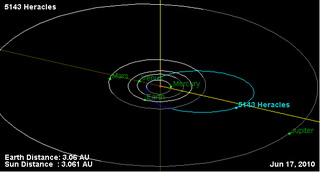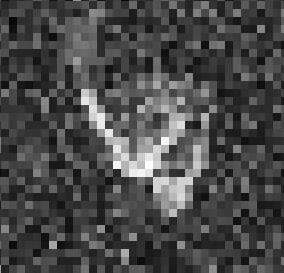Related Research Articles
2063 Bacchus, provisional designation 1977 HB, is a stony asteroid and near-Earth object of the Apollo group, approximately 1 kilometer in diameter. The contact binary was discovered on 24 April 1977, by American astronomer Charles Kowal at the Palomar Observatory in California, United States. It was named after Bacchus from Roman mythology.
(35396) 1997 XF11, provisional designation 1997 XF11, is a kilometer-sized asteroid, classified as a near-Earth object, Mars-crosser and potentially hazardous asteroid of the Apollo group.

4183 Cuno, provisional designation 1959 LM, is an eccentric, rare-type asteroid, classified as near-Earth object and potentially hazardous asteroid of the Apollo group, and measures approximately 4 kilometers in diameter.
(6178) 1986 DA is a metallic asteroid, classified as near-Earth object of the Amor group, approximately 3 kilometers in diameter. It was discovered on 16 February 1986, by Japanese astronomer Minoru Kizawa at Shizuoka Observatory, Japan.
1866 Sisyphus is a binary stony asteroid, near-Earth object and the largest member of the Apollo group, approximately 7 kilometers in diameter.
5653 Camarillo ( KAM-ə-REE-oh), provisional designation 1992 WD5, is a stony asteroid and near-Earth object of the Amor group, approximately 1.5 kilometers in diameter.

3752 Camillo is an inclined contact-binary asteroid, classified as near-Earth object of the Apollo group, approximately 2.3 kilometers in diameter. It was discovered on 15 August 1985, by astronomers Eleanor Helin and Maria Barucci using a 0.9-metre (35 in) telescope at the CERGA Observatory in Caussols, France. Lightcurve studies by Petr Pravec in 1998 suggest that the assumed S-type asteroid has an elongated shape and a longer-than average rotation period of 38 hours.

65803 Didymos is a sub-kilometer asteroid and binary system that is classified as a potentially hazardous asteroid and near-Earth object of the Apollo group. The asteroid was discovered in 1996 by the Spacewatch survey at Kitt Peak, and its small 160-meter minor-planet moon, named Dimorphos, was discovered in 2003. Due to its binary nature, the asteroid was then named Didymos, the Greek word for 'twin'.

5143 Heracles, provisional designation 1991 VL, is a highly eccentric, rare-type asteroid and synchronous binary system, classified as near-Earth object of the Apollo group, approximately 4.8 kilometers in diameter. The asteroid was discovered on 7 November 1991, by American astronomer Carolyn Shoemaker at Palomar Observatory in California, United States. It is named for the Greek divine hero Heracles. It has an Earth minimum orbit intersection distance of 0.058 AU (8.7 million km) and is associated with the Beta Taurids daytime meteor shower.
7088 Ishtar, provisional designation 1992 AA, is a synchronous binary asteroid and near-Earth object from the Amor group, approximately 1.3 kilometers in diameter. It was discovered on 1 January 1992, by American astronomer Carolyn Shoemaker at the Palomar Observatory in California. The relatively bright asteroid with an unknown spectral type has a rotation period of 2.7 hours. In December 2005, a 330-meter sized satellite was discovered, orbiting its primary every 20.65 hours.
11066 Sigurd, provisional designation 1992 CC1, is a stony, rare-type asteroid and elongated contact binary, classified as near-Earth object of the Apollo group of asteroids, approximately 2.5 kilometers in diameter.
5370 Taranis, provisional designation 1986 RA, is an asteroid and suspected dormant comet on an eccentric orbit, classified as near-Earth object of the Amor group, approximately 5 kilometers in diameter.
(5646) 1990 TR is a probable rare-type binary asteroid classified as near-Earth object of the Amor group, approximately 2.3 kilometers in diameter. It was discovered on 11 October 1990, by Japanese astronomers Seiji Ueda and Hiroshi Kaneda at Kushiro Observatory near Kushiro, in eastern Hokkaido, Japan.
(467336) 2002 LT38, is a sub-kilometer asteroid and suspected tumbler, classified as a near-Earth object and potentially hazardous asteroid of the Aten group, approximately 240 meters (790 ft) in diameter. It was discovered on 12 June 2002, by astronomers of the Lincoln Near-Earth Asteroid Research at the Lincoln Laboratory's Experimental Test Site near Socorro, New Mexico, in the United States.

(7482) 1994 PC1 is a stony asteroid, classified as near-Earth object and potentially hazardous asteroid of the Apollo group, approximately 1.1 kilometers in diameter. It was discovered on 9 August 1994, by astronomer Robert McNaught at the Siding Spring Observatory in Coonabarabran, Australia. With an observation arc of 47 years it has a very well known orbit and was observed by Goldstone radar in January 1997. The 2022 approach has been observed every month since August 2021.

(192642) 1999 RD32, provisional designation: 1999 RD32, is an asteroid and suspected contact binary on an eccentric orbit, classified as a large near-Earth object and potentially hazardous asteroid of the Apollo group, approximately 5 kilometers (3 miles) in diameter. It was discovered on 8 September 1999, at a magnitude of 18, by astronomers of the LINEAR program using its 1-meter telescope at the Lincoln Laboratory's Experimental Test Site near Socorro, New Mexico, United States. The asteroid is likely of carbonaceous composition and has a rotation period of 17.08 hours.

(341843) 2008 EV5, provisional designation 2008 EV5, is a sub-kilometer asteroid, classified as a near-Earth object and potentially hazardous asteroid of the Aten group, approximately 400 metres (1,300 feet) in diameter. It was discovered on 4 March 2008, by astronomers of the Mount Lemmon Survey at Mount Lemmon Observatory near Tucson, Arizona, United States.
21088 Chelyabinsk, provisional designation 1992 BL2, is a stony asteroid and near-Earth object of the Amor group, approximately 4 kilometers in diameter. It was discovered on 30 January 1992, by Belgian astronomer Eric Elst at ESO's La Silla Observatory in northern Chile. The asteroid was named after the Russian city of Chelyabinsk and for its spectacular Chelyabinsk meteor event in 2013.
(163243) 2002 FB3, provisional designation 2002 FB3, is a stony asteroid on an eccentric orbit, classified as near-Earth object and potentially hazardous asteroid of the Athen group, approximately 1.6 kilometers (1 mile) in diameter. It was discovered on 18 March 2002, by astronomers with the Lincoln Near-Earth Asteroid Research at the Lincoln Laboratory's Experimental Test Site near Socorro, New Mexico, in the United States. The Q-type asteroid has a rotation period of 6.2 hours.

(164121) 2003 YT1, provisional designation 2003 YT1, is a bright asteroid and synchronous binary system on a highly eccentric orbit, classified as near-Earth object and potentially hazardous asteroid of the Apollo group, approximately 2 kilometers (1.2 miles) in diameter. It was discovered on 18 December 2003, by astronomers with the Catalina Sky Survey at the Catalina Station near Tucson, Arizona, in the United States. The V-type asteroid has a short rotation period of 2.3 hours. Its 210-meter sized minor-planet moon was discovered at Arecibo Observatory in May 2004.
References
- 1 2 3 4 5 6 7 8 9 10 11 "JPL Small-Body Database Browser: 4486 Mithra (1987 SB)". Jet Propulsion Laboratory . Retrieved 4 July 2017.
- ↑ "Mithras, Mithra" . Oxford English Dictionary (Online ed.). Oxford University Press.(Subscription or participating institution membership required.)
- 1 2 3 Schmadel, Lutz D. (2007). "(4486) Mithra". Dictionary of Minor Planet Names – (4486) Mithra. Springer Berlin Heidelberg. p. 386. doi:10.1007/978-3-540-29925-7_4429. ISBN 978-3-540-00238-3.
- 1 2 3 "4486 Mithra (1987 SB)". Minor Planet Center. Retrieved 10 August 2016.
- 1 2 3 4 Mainzer, A.; Grav, T.; Masiero, J.; Hand, E.; Bauer, J.; Tholen, D.; et al. (November 2011). "NEOWISE Studies of Spectrophotometrically Classified Asteroids: Preliminary Results". The Astrophysical Journal. 741 (2): 25. arXiv: 1109.6407 . Bibcode:2011ApJ...741...90M. doi:10.1088/0004-637X/741/2/90. S2CID 35447010.
- 1 2 3 Mainzer, A.; Grav, T.; Bauer, J.; Masiero, J.; McMillan, R. S.; Cutri, R. M.; et al. (December 2011). "NEOWISE Observations of Near-Earth Objects: Preliminary Results". The Astrophysical Journal. 743 (2): 17. arXiv: 1109.6400 . Bibcode:2011ApJ...743..156M. doi:10.1088/0004-637X/743/2/156. S2CID 239991.
- 1 2 3 4 5 "LCDB Data for (4486) Mithra". Asteroid Lightcurve Database (LCDB). Retrieved 10 August 2016.
- 1 2 3 Brozovic, Marina; Benner, Lance A. M.; Magri, Christopher; Ostro, Steven J.; Scheeres, Daniel J.; Giorgini, Jon D.; et al. (July 2010). "Radar observations and a physical model of contact binary Asteroid 4486 Mithra" (PDF). Icarus. 208 (1): 207–220. Bibcode:2010Icar..208..207B. doi:10.1016/j.icarus.2010.01.035.
- ↑ Ostro, S. J.; Hudson, R. S.; Benner, L. A. M.; Nolan, M. C.; Margot, J.-L.; Giorgini, J. D.; et al. (October 2000). "Radar Observations of Asteroid 4486 Mithra". American Astronomical Society. 32: 1003. Bibcode:2000DPS....32.0807O.
- ↑ Veres, Peter; Jedicke, Robert; Fitzsimmons, Alan; Denneau, Larry; Granvik, Mikael; Bolin, Bryce; et al. (November 2015). "Absolute magnitudes and slope parameters for 250,000 asteroids observed by Pan-STARRS PS1 – Preliminary results". Icarus. 261: 34–47. arXiv: 1506.00762 . Bibcode:2015Icar..261...34V. doi:10.1016/j.icarus.2015.08.007. S2CID 53493339.
- ↑ "Horizons Batch for 2023-04-11 Close Approach". JPL Horizons. Archived from the original on 25 October 2022. Retrieved 4 April 2023. RNG_3sigma = uncertainty range in km. (JPL#233/Soln.date: 2022-Sep-20 generates RNG_3sigma = 134 km)
- ↑ "Horizons Batch for 2150-11-04 Venus Close Approach". JPL Horizons. Archived from the original on 26 October 2022. Retrieved 4 April 2023. RNG_3sigma = uncertainty range in km. (JPL#233/Soln.date: 2022-Sep-20 generates RNG_3sigma = 1625 km)
- ↑ Lance A. M. Benner (18 November 2013). "Binary and Ternary near-Earth Asteroids detected by radar". NASA/JPL Asteroid Radar Research. Archived from the original on 8 June 2004. Retrieved 1 March 2014.
- ↑ Michael Busch (12 March 2012). "Near-Earth Asteroids and Radar Speckle Tracking" (PDF). Retrieved 10 August 2016.
- ↑ "MPC/MPO/MPS Archive". Minor Planet Center. Retrieved 10 August 2016.